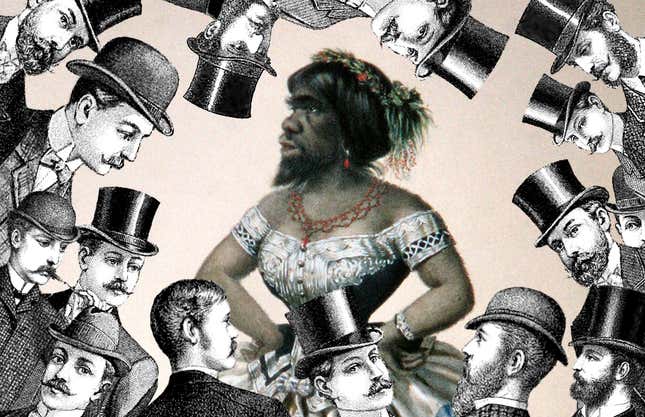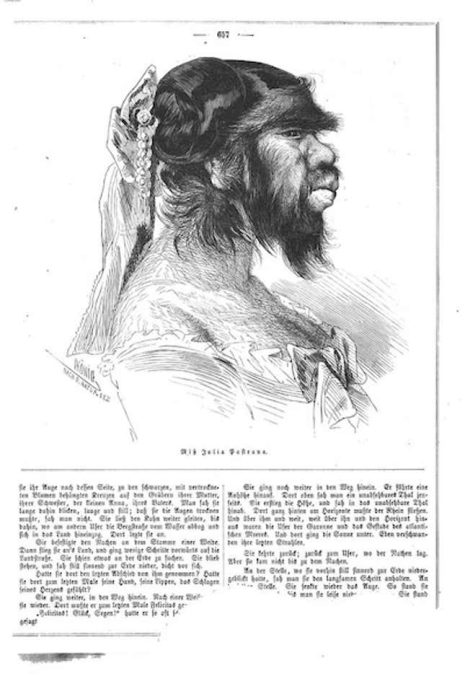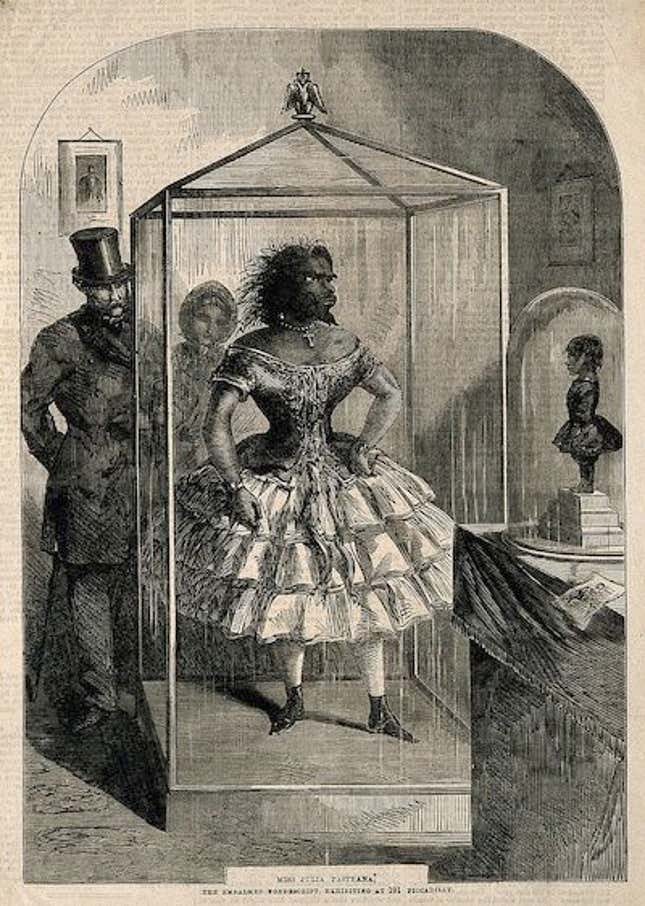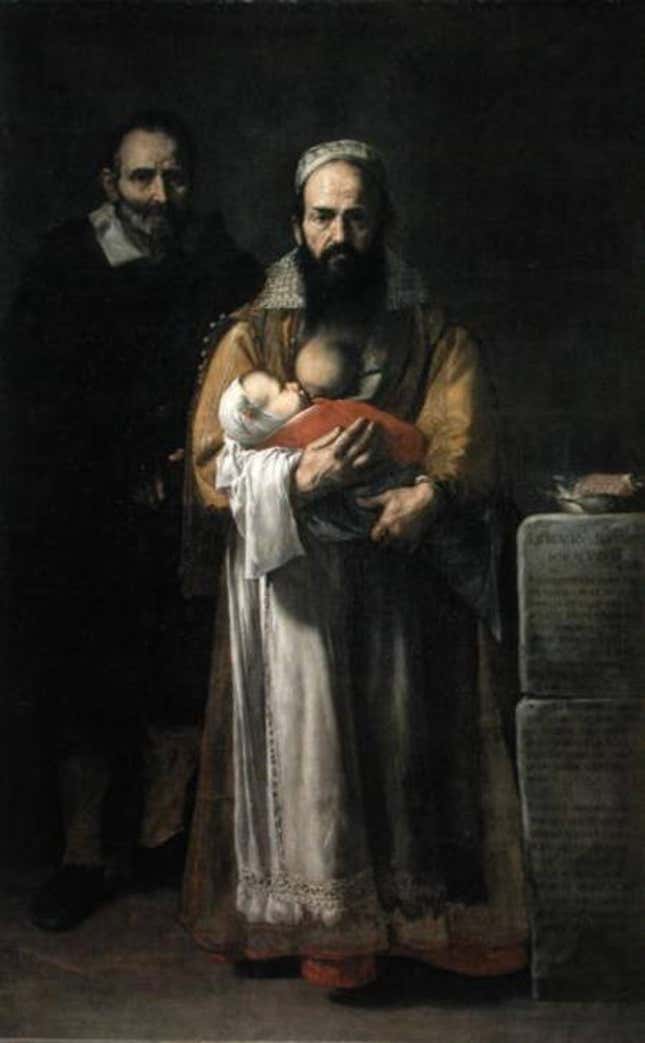The Life and Death of Julia Pastrana, Bearded Woman on Parade
In Depth

One of the best beards in history was grown by a woman named Julia Pastrana.
Records are blurry, but she was likely born in 1834 somewhere in Mexico, on the Western slopes of the Sierra Madre: a small, dark, hairy infant born to a poor Indian woman. Jan Bondeson writes in A Cabinet of Medical Curiosities, “According to the exaggerated accounts in the contemporary exhibition pamphlets, an Indian woman named Espinosa had become separated from her tribe in 1830, and was believed to have drowned. Six years later, however, some cowboys found her in a cave. She told them that she had been captured by a party of hostile Indians, who had imprisoned her in the cave, but no human beings could be found nearby.”
Espinosa had a child with her; she said the child wasn’t hers, but she cared for her and loved her. This child was christened Julia Pastrana. Years after this, Bondeson writes, Pastrana’s “supposed mother” died and the child was sent to a nearby city.
In an article for the Public Domain Review, Bess Lovejoy, author of Rest in Pieces: The Curious Fates of Famous Corpses, describes Julia Pastrana’s origins differently, and a little more clearly. She writes, “The local native tribes often blamed the naualli, a breed of shape-shifting werewolves, for stillbirths and deformities, and after seeing her daughter for the first time, Julia’s mother is said to have whispered their name. She fled her tribe—or was cast out—not long after.” Years later, according to Lovejoy, Pastrana and Espinosa (in this account, actually Julia’s mother) were found in a cave and taken to a city, where the child was placed in an orphanage. In both stories, she came out of the womb dark and hairy, with thick lips and wide ears. No one could explain it.
There are other stories about her origins, too, most a little more dubious and a lot more sinister. In 1854, when Pastrana went on tour, she was marketed both as a hybrid of monkey and man and also as a “bear woman.” A sensational pamphlet written by Pastrana’s manager and later husband, Theodore Lent, insinuated that Pastrana’s mother had gotten lost in the mountains and copulated with apes, baboons and bears. He wrote that she was “a hybrid, wherein the nature of woman predominates over the ourang-outang’s.”
Funny words about your wife—but Theodore Lent was a particular type, anyway. He met Pastrana while she was touring the US, and when she died after six years of displaying her face and body’s thick, coarse black hair, Lent had her and their infant son stuffed, mounted and displayed like trophies. Later, he married another bearded lady, eventually displaying her alongside the stuffed corpse of his first wife and baby boy.
Before that, as a young woman, Pastrana had been taken in by the governor of the state of Sinaloa, who wanted to study her curious body. She was a servant girl for him and left in 1854 because of how horribly she was treated in the house. On her way back to her village, she met an American, M. Rates, who convinced her to tour with him.
I wonder how the American convinced her. By all accounts, Pastrana was a quiet and polite girl, very focused on propriety. Manners, maybe, were more controllable than the hair that sprang off her in coils. So, what did M. Rates say? Was it the money? The adventure? M. Rates was a proficient showman; he had experience dealing with “oddities” like Pastrana. Maybe he talked to her kindly—something few people had done, or ever would do.

At any rate, in America, she was a celebrity: shown to professors, danced at balls. Eventually she met up with Lent, who made his contract with Pastrana more permanent by marrying her. Lent essentially pimped his wife out: he subjected Pastrana to full medical examinations by the leading doctors in the towns they toured in. More than one source describes Pastrana as resistant to these examinations, during which she was often silent and Lent did the talking. Lovejoy records the words of the zoologist Francis Buckland, who examined Pastrana in 1857, as having an “exceedingly good figure” despite being “hideous.” Bondeson quotes a Dr. J.Z. Laurence, who wrote in The Lancet that with the exception of her palms and feet, she was hairy everywhere, “especially on those parts that are ordinarily covered with hairs in the male sex.”
Most descriptions of Pastrana inspire shudders not because of what they reveal about Pastrana but rather because of what they reveal about the men describing her. Because a beard, at the time, was a strangely precious thing. They were just coming into fashion again. They were very important to the men of the mid-19th century.
Previously, beards had been widely eschewed as the symbol of the radical leftist: the wild unkemptness of Karl Marx and his kin. But then, as American imperialism reached a fever pitch, with genocides against the Native Americans and the U.S. Indian War, beards were reclaimed as an ultimate symbol of manhood. Writing in The Atlantic, Sean Trainor notes:
A 21-part series in Boston’s Daily Evening Transcript, published in late 1856, was typical of such efforts. In these wide-ranging articles, pro-beard polemicists argued that the beard represented a rugged and robust ideal of manhood, proving white Americans’ dominion over ‘lesser’ men and ‘inferior’ races. The pseudonymous ‘Lynn Bard,’ for instance, claimed that men took up shaving ‘when they began to be effeminate, or when they became slaves.’
And it wasn’t just America: London was having a beard revival as well. Christopher Oldstone Moore writes in an article published in Victorian Studies, “The reasons given for wearing beards were remarkably consistent during the 1850s and 1860s. At the core of this consensus was the idea that beards were integral to that elemental masculinity which still pertained in the modern age, first by contributing to men’s health and vitality, and second by serving as the outward mark.”
Pastrana arrived just at that moment in history when the beard was becoming a symbol of men and manifest destiny—and she upended it all. Her presence challenged the idea that a beard was distinctly male and distinctly human. Pastrana’s body was in a liminal space: No wonder these men want to poke and prod her hairy regions. Aside from base prurience, they were seeking boundaries and borders. They were seeking a way to define and thus control this female body, which threatened every aspect of what it meant to be a Victorian male.
But they couldn’t. So she was mocked and ridiculed. In a poem titled “Pastrana,” Arthur Munby writes a horrific tale of being unable to shake the attentions of an ape woman.
To see myself foil’d in that lonely place/ By a desperate brute with a monstrous face/ And hugg’d to death in the foul embrace/ Of a loathly angry ape.
For the ape was nearly as tall as a man/ So it seem’d to me the safest plan/ To leave her at once, ere her wrath began/
To spread from her glowing eyes/To the long sharp nails of her powerful hands/ For the Lex Talionis and its commands/Are just what the creature understands/And just what her passions prize.
In reading the poem, it’s clear that the problems are Munby’s, not Pastrana’s. He’s afraid that his masculinity can’t stand up to her image, the boundary-crossing power it represents.
There were of course, hairy men who were just as exploited: for example. the infamous Jo-Jo the Dog Faced Boy, who used to bark and chew bones in front of a crowd. Adrian Jeftichew (Jo-Jo’s father) had been put on display also, marketed as the offspring of the illicit affair between a Russian peasant woman and a bear. But for these men, there was no extra effort made—or necessary—to ascertain their gender, or probe the thresholds of their bodies. I’ve read no reports of any bearded men being made to endure silent “medical” examination: no extra fees for their managers to permit them the privilege of inspection.
It’s notable that Lent often made his wife wear costumes that exaggerated her femininity. She was often seen carrying flowers. But Bondeson writes, “…it was only to emphasize the difference between her and the rest of her sex.”
The more Pastrana tried to be a woman, the less of one she became. She had the marking of the manliest of men; and yet she was owned and exploited like only a woman could be. To give her show a hint of respectability, Pastrana learned to sing and dance. But no matter what she did, her big, hairy beard was considered obscene and scandalous.
After all, when the definition of woman is in flux, so is the definition of man.
Pastrana wasn’t the only famous bearded lady. In the 17th century, for one example, there was Barbara Urslerin, who was often examined in the same way. Bondeson, writing in another book (The Two-Headed Boy), tells of one man, a M. Brackenhoffer, who paid an extra fee to undress Urslerin and subsequently described her breasts, her skin, and then declared her to be a “true woman.” French anthropologists A.F. Double and Francis Houssay wondered if Urslerin was a prostitute, a theory that Bondeson dismisses, noting. “At this time, it was the custom that any person paying to see a human or animal curiosity also had the right to thoroughly examine the creature on show.”
It’s human instinct to be curious about people who are visually outside our norms. Dr. Judith Hall, a pediatrician and geneticist who works with dwarfism, told me, “Our natural instinct to stare and wonder is not inherently bad.” Then, she added, “But it’s when our stare erases someone’s personhood; that is when it is dangerous.”
Writing in Representations of Hair in Victorian Literature and Culture Galila Ofek notes:
It is important to analyze Victorian scientific treatment of both female hairiness and primitive fetishism with the the context of contemporary fascination with evolutionary thought. […] Excessive hair denoted, in evolutionary terms, a ‘debased state or stage’, which was presumed to be ‘at the very beginning of human evolution…
That’s where the bearded ladies lay: as representations of the primitive and the animal. Made inhuman, they weren’t allowed even a humane death.
In Pastrana’s case, her husband allowed people to come watch her on her deathbed, just a few days after giving birth to their son (who was born hairy like his mother, and only lived for 35 hours). As Lent made more money and she slipped into death, onlookers reportedly heard her say, “I die happy; I know I have been loved for myself.” You wonder if she believed it.
Not long after she died, Lent sold her body and the body of their son to an embalmer, Professor Sukolov of Moscow University. Their mummies became quite an attraction, displayed in the anatomical museum of the University of Moscow. Pastrana’s embalmed body was dressed in a Russian dancer’s dress, her son in a sailor suit. An English zoologist and natural historian who had seen Pastrana in life went to see her again as a stuffed doll, describing her like this:
The closest examination convinced me that it was the true skin, prepared in some wonderful way; the huge deformed lips and the squat nose remaining exactly as in life; and the beard and luxuriant growth of soft black hair on and about the face were in no respect changed from their former appearance.
His gleefulness still trips through his words so many decades later.

Pastrana and her son’s popularity as an exhibit soon convinced Lent he had to have them back, and so he did. For the next ten years, he took his dead wife on tour all over Europe. He also brought along his new wife, Marie Bartel, whose name he changed—no joke—to Zenora Pastrana.
Eventually, Lent retired from show business, bought a wax museum in St. Petersburg and let the Prauscher Museum keep the mummies in return for a large salary. Then, in 1884, he went insane. Bondeson writes that he “began to dance in the streets and to tear up the bank notes and stock certificates he had earned in such a particular way and throw them in the river Neva.” He was taken to an asylum, at which point Zenora took herself on tour with the bodies. In 1889, she gave the mummies to a German named J.B. Gassner, who displayed them at fairs, circuses and anthropological visits.
And this was the fate of Pastrana for the next century, tossed about on display, spending intermittent years in storage, only to be found again and gawked at. The mummies ended up in Sweden; in 1973, Sweden banned the display of corpses. So into a basement Pastrana and her son went. Lovejoy writes, “Three years later, teenagers broke in and ripped off Julia’s arm, thinking she was a mannequin. The police later recovered the bodies, but Julia’s infant was damaged beyond repair. He ended up in the trash.”
In 1990, Pastrana’s body was rediscovered. After much debate, she was displayed again in the Institute of Basic Medical Science at the University of Oslo. Then, in 2005, an artist in residency in Oslo, Laura Anderson Barbata, began to petition for the burial of Pastrana. After the government of Mexico got involved, Pastrana finally found her escape. In 2013, she was buried near her birthplace in Sinaloa de Leyva.
Centuries before Pastrana was born, Jusepe de Re Ribera painted a portrait of Magdalena Ventura, a Spanish woman who at 37 grew a beard. She was married and had three sons.
The painting is titled The Bearded Woman. Ribera gave the painting an inscription. Here is a translation:
Look, a great miracle of nature. Magdalena Ventura from the town of Accumulus in Samnium, in the vulgar tongue Abruzzo in the Kingdom of Naples, aged 52 and what is unusual is when she was in her 37th year she began to go through puberty and thus a full growth of beard appeared such that it seems rather that of a bearded gentleman than a woman who had previously lost three sons whom she had borne to her husband, Felici de Amici, whom you see next to her. Joseph de Ribera, a Spaniard, marked by the cross of Christ, a second Apelles of his own time, by order of Duke Ferdinand II of Alcalá, Viceroy at Naples, depicted in a marvellously lifelike way. 17th February 1631.

Ribera calls her a gentleman and paints her as one. In fact, she looks exactly like the man who painted my house last summer—sallow cheeked with an unruly beard.
But there, as if Ribera had to plop on a reminder of her womanhood, is a boob. Right in the middle of her chest. And lest you forget it’s a boob, she is breastfeeding. Additionally depicted in the painting are a spindle and a shell, symbols of womanhood (their work and their vaginas, how apt).
It’s almost laughable, as if Ribera has completely forgotten what women look like. “Oh right, boobs… and they use spinning wheels, probably… also they have vaginas… so we’ll throw in some shells?” But the painting produces the same effect that all natural abnormality provokes in us. We want her to look one way—normal. She looks the opposite. She can’t change. So we stare, as if our gaze will take away the power of who she is.
But women are only allowed to finally refuse the gaze in fiction.
In Don Quixote, the hero meets a bunch of shepherds at a funeral of one of their own. The shepherd has died, presumably, from a broken heart after being rejected by a woman, named Marcela who is living alone in the mountains. The shepherds spend the funeral blaming her for their friends death, until she shows up and rebukes them, telling them that she hadn’t invited their advances.
She tells them, “I know, with the natural understanding that God has given me, that everything beautiful is lovable, but I cannot grasp why, simply because it is loved, the thing loved for its beauty is obliged to love the one who loves it.”
Then, she walks away, never to come back in the novel.
I think of Marcela when I think of Pastrana: two women, forced for different reasons into an unrelenting gaze, forced because of their bodies to become an object, of leering ridicule and coarse categorization. Both women who just wanted to rest.
Lyz Lenz has written for The Hairpin, The Toast, The New York Time Motherlode, and other various and sundry internet entities. Find her on twitter @lyzl.
Image by Jim Cooke. Additional images via Wikimedia Commons.